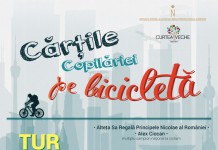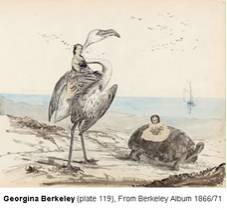 In the mid-19th century, a sudden cultural mix of early photography, science à la Darwin and fantasy by way of Lewis Carroll fueled an ironic response from certain educated Victorian ladies, whose pastimes included scrapbook diaries, parlor games (such as exquisite corpse) and—as on vivid display at the Met—photocollaged family albums. Witty, sarcastic, and surreal, the work in these albums comprises a collective portrait of Victorian British aristocracy and a time capsule of the arts, sports and fashions of the era. Collage and exquisite corpse were adopted half a century later by the cubists, dadaists, constructivists and surrealists as their own inventions, re-expressed in collective drawings, poetry and assemblages. Even the magazines and books of the Victorian era were recycled 50 years later by Max Ernst and his followers in whimsical collages, including the collage-novellas of the 1920s and 30s, most famously in Ernst’s The Hundred Headless Woman (1929).
In the mid-19th century, a sudden cultural mix of early photography, science à la Darwin and fantasy by way of Lewis Carroll fueled an ironic response from certain educated Victorian ladies, whose pastimes included scrapbook diaries, parlor games (such as exquisite corpse) and—as on vivid display at the Met—photocollaged family albums. Witty, sarcastic, and surreal, the work in these albums comprises a collective portrait of Victorian British aristocracy and a time capsule of the arts, sports and fashions of the era. Collage and exquisite corpse were adopted half a century later by the cubists, dadaists, constructivists and surrealists as their own inventions, re-expressed in collective drawings, poetry and assemblages. Even the magazines and books of the Victorian era were recycled 50 years later by Max Ernst and his followers in whimsical collages, including the collage-novellas of the 1920s and 30s, most famously in Ernst’s The Hundred Headless Woman (1929).
In Playing with Pictures: The Art of Victorian Photocollage, organized by Elizabeth Siegel, associate curator of photography at the Art Institute of Chicago, where the show originated, eleven albums depicting the well-to-do of the 1860s and 70s are presented under glass, in a jewel-box display, although all of the albums’ pages can be viewed on special computer monitors installed in the gallery. The show is well represented by a lavish catalog from the AIC and Yale Press, where art historians such as Patrizia di Bello, Marta Weiss and Miranda Holfelt contribute thoughtful essays. The visual language developed during this period had several ingredients: art education and appreciation, plus an interest in popular photography. The latter got a boost in 1854 when Frenchman Andre Adolphe Disderi invented a process that enabled the carte de visite: a 2.5-by-4-inch cardboard calling card with a photo on it—the Facebook photo of its day. A new upper-class ritual developed, in which suitors gave the cards to the women they pursued, and they in turn collected them as keepsakes (if not trophies). But, as di Bello points out in the catalogue, by the 1860s, cartes de visite were becoming cheap enough for even working-class people to buy, exchange and collect, and so the upper crust upped the ante by adding artistic touches to the albums in which they displayed their collections of cards. These touches typically included collages using an image of a drawing-room, an outdoor veranda or a landscape painted by hand as a background setting, with cut-up photos of family members and friends pasted into the composition, often positioned in order of importance or sometimes turned into something else entirely.
One of the collagists was Georgina Berkeley (1831-1919), the great-granddaughter of the fourth Earl of Berkeley, and whose 13 artworks made between 1866 and 1871 are presented in the second room of the exhibition as individual pieces unbound from her album. She lived the last decade of her life in total obscurity, at the same time that Picasso, Braque and many dadaists were taking the credit for the invention of collage and photomontage. A standout is Berkeley’s drawing-collage depicting a circus performance by a working-class acrobat sporting the head of an elite gentleman as he jumps through burning hoop—a masterpiece of sarcasm. Berkeley’s inventions were imitated, perhaps unknowingly, by Max Ernst and later by Saul Steinberg in his graphics and collages.
Another source of inspiration for the photo-collages of that era was the practice of living room theater as a form entertainment: tableaux vivants and charades performed in front of Victorian drawing-room audiences. In the accompanying catalogue’s essay, “The Page as Stage—From Tableaux Vivants to Paste Pot,” Marta Weiss notes that Lewis Carroll was present in 1860 at a state dinner for the Prince of Wales and, after seeing a tableaux vivant of Tennyson’s “The Sleeping Princess” performed by children, was inspired to begin photographing children dressed in exotic costumes.
In the Bouverie Album, Elizabeth and Jane Pleydell-Bouverie reproduce the famous Tenniel illustrations from “Alice’s Adventure in Wonderland” in pencil but glue in their own photograph for Alice. In the same album, ladies wearing fancy hats and playing tennis are caricatured with big photo heads, opposite male counterparts. One page features more than thirty characters at a garden party, all skittering about and dressed for a ball. The album also contains drawings of a lady’s fan emblazoned with the picture of a shell brimming with children’s heads and silhouettes of animals and peasants, an allusion to urban folklore.
In the Westmorland Album (1870), Eva Macdonald drew all the dancers at the Ball at Brocklesby and inserted photographs for their heads, with deliberately comic disproportions of scale that seem to time-travel to Monty Python’s Flying Circus.
Marie-Blanche-Hennelle Fournier (1831-1906) made compositions with photographs and watercolors that are fantastical combinations of human heads and animal bodies, as with a turkey sprouting 19 photo-heads from its tail feathers; she also placed people into imaginary scenarios, such as the ten members of high society caught in a giant web. The only male artist represented, Sir Edward Charles Blount, constructed his pages with photographs of men in high hats carrying hunting rifles astride live or wooden horses or unicycles; the masculine tone of the collages is underscored by a perfect compositional symmetry. My favorite of the Blount Album shows faces morphed, via cut and paste, into common household objects such as a matchbox, a book cover, a candleholder, and a cooking pot containing a “boiling head.” There are also several paper dolls with photo-heads, a playing card with a collaged face, and even soft-boiled eggs ejaculating the heads of children. Food is also the focus of a caricature from Victoria Alexandrina Anderson-Pelham, Countess of Yarborough, from the Westmorland album, showing a man trying to spear “pickled” society heads floating in brine. Featuring approximately 50 works from public and private collections, including many that have never been exhibited before, Playing with Pictures provides a fascinating investigation of the creative possibilities of 19th century photography and opens a new debate over the inventors of collage.














































